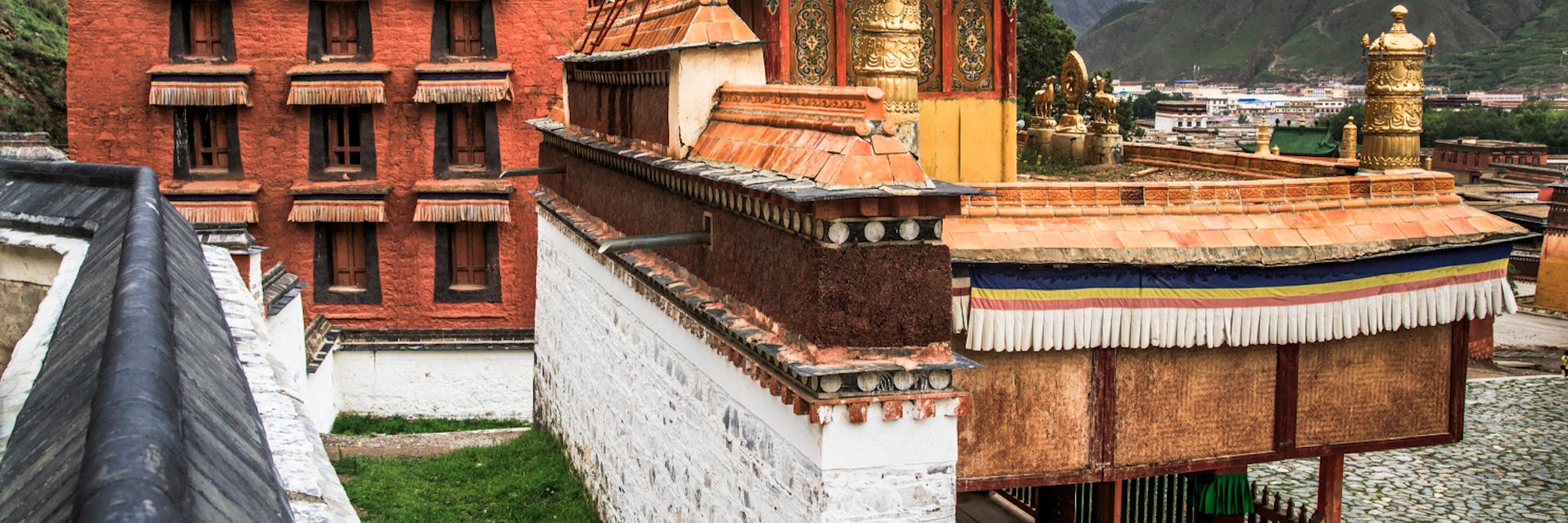With its succession of squeaking prayer wheels (3km in total), hawks circling overhead and the throb of Tibetan longhorns resonating from the surrounding hills, Labrang is a monastery town unto itself. Many of the chapel halls are illuminated in a yellow glow by flickering yak-butter lamps, their strong-smelling fuel scooped from voluminous tubs. Even if Tibet is not on your itinerary, the monastery sufficiently conveys the mystique of its devout persuasions, leaving indelible impressions of a deeply sacred domain.
In addition to the chapels, residences, golden-roofed temple halls and living quarters for the monks, Labrang is also home to six tratsang (monastic colleges or institutes), exploring esoteric Buddhism, theology, medicine, astrology and law. No photography is allowed within the temple halls, with a ¥500 fine in some places.
Labrang Monastery was founded in 1709 by Ngagong Tsunde (E’angzongzhe in Chinese), the first-generation Jamyang (a line of reincarnated Rinpoches or living Buddhas ranking third in importance after the Dalai and Panchen lamas), from nearby Ganjia. The monastery is one of the six major Tibetan monasteries of the Gelugpa order (Yellow Hat sect of Tibetan Buddhism). The others are Ganden, Sera and Drepung monasteries near Lhasa; Tashilhunpo Monastery in Shigatse; and Kumbum Monastery outside Xining in Qinghai.
At its peak, Labrang housed nearly 4000 monks, but their ranks greatly declined during the Cultural Revolution. Modern Labrang is again such a popular destination for young disciples that numbers are currently capped at 1800 monks, with about 1600 currently in residence, drawn from Qinghai, Gansu, Sichuan and Inner Mongolia.
Main Buildings
The only way to visit the interior of the most important buildings is on a tour (no photos allowed inside buildings), which generally includes the Institute of Medicine, the Manjushri Temple, the Serkung (Golden Temple) and the main Prayer Hall (Grand Sutra Hall) – an amazing sight, steeped in mystery and where you may be treated to the spectacle of lamas chanting in the courtyard outside – plus a museum of relics and yak-butter sculptures. English-language tours (per person ¥40) leave the monastery's ticket office around 10.15am and 3.15pm most days, and although there is plenty to see, they can feel a bit rushed. Outside those times you can latch on to a Chinese tour, with little lost even if you don't understand the language, but be aware you must purchase the ¥40 ticket to gain entrance to any of the buildings' interiors. Even better is to show up at around 6am or 7am, when the monks come out to pray and chant. At dusk the hillside resonates with the throaty sound of sutras being chanted behind the wooden doors.
Other Buildings
The rest of the Labrang can be explored by walking the inner kora, a 3.5km-long pilgrim path and the world's longest stretch of prayer wheels. Although many of the temple halls are padlocked shut, there are a couple of separate smaller chapels you can visit, though they can often be closed for unexplained reasons. Some charge admission. Among the most popular are the three-storey Barkhang, the monastery's traditional printing temple, as well as the Hall of Hayagriva with its enchanting murals, and the golden Gongtang Pagoda, which offers incredible views over the whole monastery from its roof. The Lower Tantric College (下续部学院, xiàxùbù xuéyuàn) contains some riveting tantric figures and a shrine at the rear with ancient murals. Women are not allowed to enter the Hùfǎ Shéndiàn (护法神殿, Hall of Protecting the Law). The large wall of a walled garden can also be seen, part of the monk's living quarters (no admission).
Access to the rest of the monastery area is free, and you can easily spend several hours just walking around and soaking up the atmosphere in the endless maze of mud-packed walls. The Tibetan greeting in the local Amdo dialect is Cho day mo? ('How do you do?') – a great icebreaker.
The best morning views of the monastery come from the Thangka Display Terrace, a popular picnic spot, or the forested hills south of the main town.
You'll need a ticket to enter the main monastery complex between mid-June and mid-October, when most visitors are in Xiahe, but at other times you will find you can just wander in and around the monastery (though you may not be able to access individual halls).

